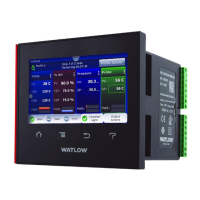Watlow F4T • 221 • Chapter 6 Appendix
31. :PROGram:SELected:NUMBer <numeric value> - Set the current profile number
- Example :PROGRAM:SELECTED:NUMBER 1 – set the current profile to profile number 1
32. :PROGram:SELected:NAME? - Query the current profile name
33. :PROGram:SELected:STEP <numeric value> - Set the current profile step
- Example :PROGRAM:SELECTED:STEP 1 – set the current profile step to step number 1
34. :PROGram:SELected:STATe STArt - Start the current profile
35. :PROGram:SELected:STATe PAUSe - Pause the current profile
36. :PROGram:SELected:STATe RESume - Resume the current profile
37. :PROGram:SELected:STATe STOP - Terminate the current profile
Introduction to the Modbus Protocol
Gould Modicon, now called AEG Schneider, first created the protocol Referred to as Modbus
RTU used in process control systems. Modbus provides the advantage of being extremely reli-
able in exchanging information, a highly desirable feature for industrial data communications.
This protocol works on the principle of packet exchanges. The packet contains the address of
the controller to receive the information, a command field that says what is to be done with
the information, and several fields of data. Each F4T parameter has a unique Modbus address
and they can be found in the table below.
All Modbus registers are 16-bits and are listed in the following table as relative addresses (ac-
tual). Some F4T parameters are contained within 32 bits (IEEE float, signed 32 bit), notice that
only one (low order) of the two registers is listed. By default, the low order word contains the
two low bytes of the 32-bit parameter. As an example, in the table below find the Universal
Input and then take a close look at the first member (Analog Input Value). Note that it lists
register 27586. Because this parameter is a float, it is actually represented by registers 27586
(low order bytes) and 27587 (high order bytes) as stated above. The Modbus specification does
not dictate which register should be high or low order therefore, Watlow provides the user the
ability to swap this order.
Note:
For the purpose of making an easy transition from the F4 to the F4T controller using
Modbus, a special set of the most commonly used F4 registers were created. Notice that
there are two tables of Modbus registers, they are unique sets of registers (not inter-
changeable) and the user must select one set or the other when implementing using
Modbus.
• Map 1 = F4T registers (default)
• Map 2 = Limited set of F4 compatible registers
To change the Modbus mapping using the F4T front panel:
1. From any screen, push the Menu button
2. Push the Settings button and then the Network button
3. Select the Ethernet communications channel
4. Scroll the screen down to find Data Map and select 1 or 2.

